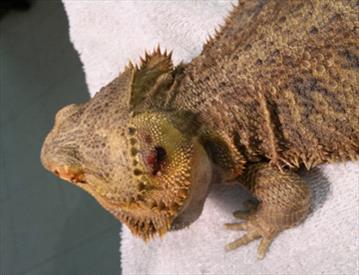Bearded dragon aneurysm McCaffery

This bearded dragon has a cervical aneurysm located just behind the jaw on the left side. Photo courtesy of Dr. Lynn McCaffery.
Lumps, bumps and swellings of all kinds are found on reptiles in many different locations but there is one condition that has started to be diagnosed with more frequency and seems to be almost exclusively seen in bearded dragons. This interesting medical condition, often referred to as aneurysm syndrome on the pet owner herp boards and chat rooms, has been seen with more frequency over the last 10 years. This condition, which generally carries a grave prognosis, has yet to be fully defined. These lumps are often called blood cysts or blood blisters.
By definition, an aneurysm is a localized enlargement of an artery. It is caused by a weakening of the artery wall. Eventually the affected blood vessel weakens to the point of bursting (rupturing). Patients with aneurysms are at high risk of bleeding to death internally if the vessel ruptures.
In bearded dragons, aneurysms can occur in many different places, including on the limbs, over the hips, in the mouth and, most commonly, over the top of the head (cephalic aneurysms). There have been a few reports describing the anatomic location of these head aneurysms and in those reports, the aneurysm arose from the internal carotid artery near its origin with the aorta.
When these vessels were looked at under the microscope, the walls of the vessels were abnormal in that they were fibrous and lacked the elasticity of normal bearded dragon vessels. So the vessels were stiff and this predisposed this high-pressure system (the internal carotid artery) to bursting and bleeding, leading to the lizard’s death.
All is not lost, though. While the reasons that aneurysms develop are not well known, there have been a number of cases that have been successfully treated with surgery.
Affected Reptiles
So far, these aneurysms have only been reported in captive bearded dragons.
Diagnosis
Your veterinarian will start with a detailed history and good physical exam. The aneurysms are often suspected when a swelling is seen on the back of the head, usually on one side or the other. Other tests that your veterinarian may want to do are X-rays, a complete blood count and chemistry panel and a fine needle aspirate of the swelling. Ultrasound examination will often show blood vessels in the mass that would help to focus the diagnosis.
Treatment
Once a cephalic aneurysm develops the only treatment option, at this time, is surgery. There are more and more successful surgeries performed for this condition, but there have not been enough studies done to be able to say what the average survival time of a bearded dragon is after a surgery for a cephalic aneurysm. In two bearded dragons that had surgery to correct this condition, one lived for nine months and the other for 18 months afterwards. Their life span is 10 to 15 years. Without surgery, the aneurysms tend to enlarge and clot over time; they eventually rupture, causing death from blood loss.
Prevention
The reason why these cervical aneurysms occur is unknown at this time. The fact that they are only seen in bearded dragons has led to speculation that there is a genetic component to developing these aneurysms.
If your lizard is diagnosed with a cephalic aneurysm, the chances of it bursting are important. In one case, a lizard died after jumping from a shelf and rupturing the aneurysm. Thus, restriction of activity is important prior to and just after surgery.
With further studies the goal is to determine what is causing these cervical aneurysms so steps can be taken to prevent them rather than attempt to treat them with dangerous and difficult surgery.